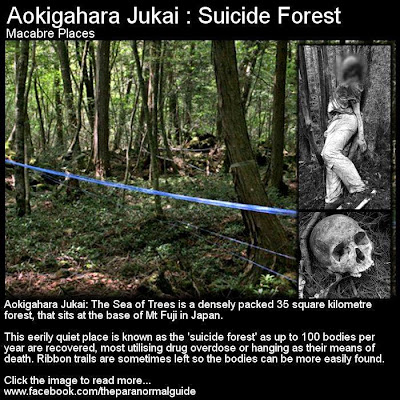Aokigahara Jukai, Dark and Macabre Places
Aokigahara Jukai, Suicide Forest, Japan
Aokigahara Jukai, Sea of Trees is a 35km square forest that lies on the north-west base of Mt Fuji in Japan. The forest floor is made up of very hard volcanic rock which anchors the thousands of trees securely to the ground. It is a popular tourist destination for its rocky, icy caverns naturally formed over the millennia.
Aokigahara is also popular with those who aim to enter the forest with no intention of ever returning. The density of the trees, and the relative lack of wildlife, gives the forest an eerily quiet yet peaceful presence. Unfortunately, those walking amongst the trees in the serenity more often than not have the peace shattered as they stumble across a body.
Aokigahara is also known as 'The Suicide Forest'.
For decades, dozens of bodies each year have been recovered from the forest. Prior to 1988 an average of 30 suicides took place within the forest each year. In 1998 the number had risen to 74 and since the start of this century the numbers have reached into the hundreds.
The two main methods people choose to suicide are by drug overdose and hanging.
Every year a small army of police, volunteers and forest workers organise a body hunt in order to recover victims of suicide. This work is also carried out year round by volunteers who enter Aokigahara in order to recover bodies, as well as hoping to dissuade those people they find in the act.
But why is this forest so popular for suicide?
Some have tried to place the blame on several books. One book 'Nami No To' ends with two lovers suicide in Aokigahara. This book was published in the 1960's however suicide within the forest predates this time.
Another book entitled 'The Complete Manual of Suicide' says Aokigahara is “the perfect place to die”.This book covers eleven different methods of suicide and places the reference to Aokigahara in the hanging section. This book was published in 1993 and has sold well over a million copies. This does put it in line with the rise in bodies recovered from the forest at that time, but nothing more substantial can link this book with the deaths (although the manual has been found in the possession of some people found within the forest.)
The Japanese government have placed many suicide prevention resources around the forest. Video cameras are located along many of the paths, nearby shops do not sell items such as rope or pills, volunteers approach those camping in the forest to make sure they are okay and a variety of signs can be found along the trails and at the forests' entrances with suicide hotline numbers.
It is not known how much of an impact these preventative measures have had on the suicide rate, although the best place to ask would be the three local villages that border the forest. These villages are responsible for the bodies that are recovered ,especially those that are unclaimed or unidentified. There are more than 200 bodies, unclaimed, that are held within these villages.
For many, the suicides have taken on a ritual bearing. Many who enter the forest with the intention of suicide will leave a trail of ribbons and streamers to their possessions, bodies and a suicide note.
The streamers will also allow them to find their way back out of the forest should they change their minds.
At other times notes are left in cars with explicit instructions that no one come looking for them.
Aokigahara is said to be haunted but not just by suicide spirits. Japanese history says Aokigahara may have been used for the practice of 'Ubasute'.
Ubasute is the practice of taking a elderly or infirm relative to a remote or desolate place and leaving them there to die via exposure, dehydration or starvation. Aokigahara is said to be haunted by the angry spirits of those left there to die.
(a note about the photo. Although the ribbons are sometimes placed so the bodies can be more easily found they are alsoleft in case a person changes their mind and wants to leave again.)

.jpg)

Komentar
Posting Komentar